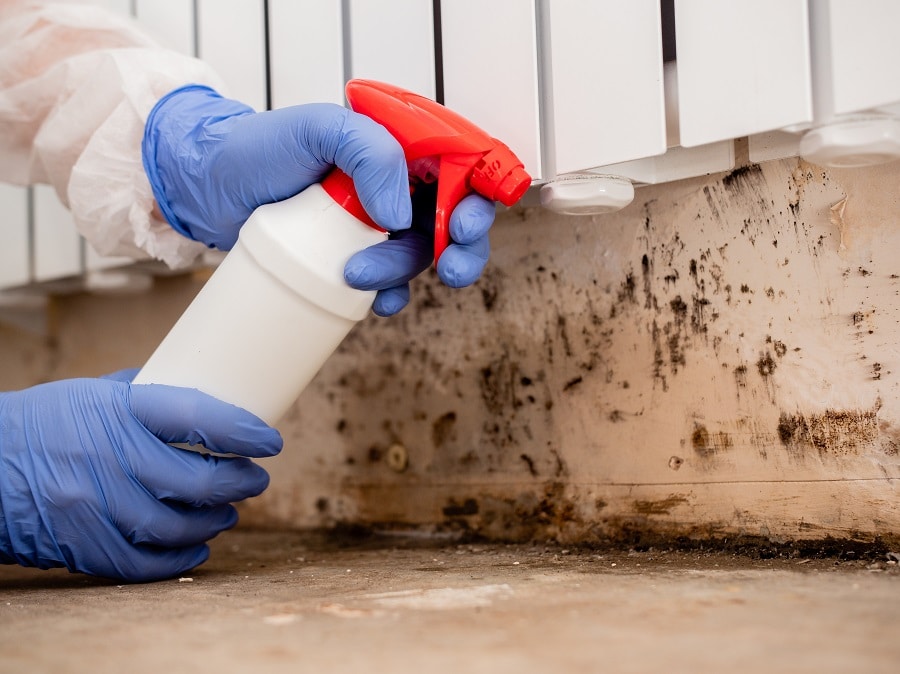What Is Wet Rot?
Wet rot is a natural decay of wood caused by excessive moisture, affecting wood with a moisture content ranging from 30 to 50 per cent. This differs from dry rot which affects wood with a moisture content of 20 per cent or less. The fungus responsible for wet rot thrives in damp environments and feeds on the timber until it’s destroyed. Coniophora Puteana, also known as basement fungus, is the most common type of wet rot fungus. Although less harmful than dry rot since it remains confined to localised areas, untreated wet rot can be equally destructive and weaken structural timbers leading to significant damage if left unaddressed. It’s important to address any signs of wet rot promptly before they escalate into more severe issues that could compromise the integrity of your structure.
Typical Causes Of Wet Rot
To effectively address wood rot, it is crucial to identify its root cause. Typically, dampness in the wood is the primary culprit. Fungus thrives in moist environments and can destroy wood over time. Dry or wet rot are common outcomes of this destructive process, but they only occur under specific environmental conditions that favour their growth. Wet rot spores require high moisture content to thrive and typically target damp woods as a result of various issues such as faulty plumbing, leaking gutters or roofs, broken pipes, washing machines or showers. If left untreated for long periods of time, wet rot can lead to significant structural damage to your home’s integrity. Two types of fungi – Coniophora puteana (black) and Fibroporia Vaillantii (white) – cause wet rot; bathrooms and basements are particularly susceptible areas due to their humid nature.
Wet Rot Thriving Conditions
Wood-decaying fungus thrives in damp, suffocating environments with little or no air circulation. The difference between wet and dry rot is a common question. Wet rot only forms in areas with high moisture levels, requiring regular exposure to thrive and spread. Faulty plumbing, gutters, downpipes, stone pointing and rainwater accumulation are all contributing factors. When wood is exposed to excessive moisture for an extended period of time, fungal spores grow causing it to lose strength and integrity leading to significant structural damage if left untreated. Wet rot can be reduced by addressing the underlying issues early on before it becomes too late. Rising damp and condensation can also cause wet rot spores to grow in any type of wood that has been exposed to dampness over time. To prevent possible wood rot from occurring altogether requires fixing any damp problems as soon as they arise before they become more severe.
Roofs And Upper Flooring Decay
Ground floor timbers are at a higher risk of being in contact with damp soil areas and rising damp, making wet rot less common in upper flooring and roof timbers. However, water penetration into the upper levels of a property can still occur due for various reasons. The most prevalent causes include faulty or damaged roofing materials, inadequate ventilation leading to condensation buildup, poorly sealed windows and doors allowing rainwater ingress, and defective plumbing systems causing leaks or bursts. It is crucial to address any signs of water damage promptly as it can lead to structural deterioration and compromise the integrity of the building’s framework. Regular inspections by professionals can help identify potential issues before they escalate into more significant problems that require costly repairs.
Upper LLevels’Rot Concerns
Water intrusion into your home can result from faulty flashing around chimneys, leading to long-term damage. This may not always be visible from inside the house and could cause rot in the timbers surrounding the chimney. It is advisable to have a roofing specialist evaluate your roof annually for any issues that may arise. Slipped tiles can also allow water in, creating ideal conditions for dry or wet rot to thrive if left unattended. Property owners should keep an eye out for wet spots or algae growth beneath gutters as this could indicate potential problems with overflow pipes emerging from walls above bathroom floors and central heating systems which mustn’t drip. Faulty plumbing hidden behind walls and beneath floors can also lead to damp concerns; therefore, it’s essential to contact a plumber immediately if such issues are discovered and ensure that the affected area is thoroughly dried out.
Differences Between Wet Rot And Dry Rot
Distinguishing between wet rot and dry rot fungi that damage wood can be challenging, but there are some key differences to look out for. Wet rot is typically caused by high moisture content in the timber, while dry rot thrives in damp environments. Additionally, wet rot tends to affect only the area where moisture is present, whereas dry rot can spread throughout a building’s structure if left untreated. Another distinguishing factor is the appearance of the affected wood: wet rotted timber will appear darker and softer than unaffected areas, while dry-rotted wood may have a distinct mushroom-like growth with deep cracks or cuboidal fractures. It’s important to identify which type of fungus is causing damage as treatment methods vary depending on the specific type of infestation present.
Dry Rot Symptoms
Dry rot is a fungal decay that can cause structural damage to wood, even far from the source of moisture. It manifests as visible fissures along and across the grain of the wood, with mycelium growth often present on its surface. The young fungus appears white like cotton wool but fades to grey over time. Dry rot can colonise more wood by growing through mortar beds in brick walls. Its fruiting bodies produce crimson spore dust. Wet rot germinates on damp wood with a moisture content exceeding 20%, while dry rot thrives on wet wood containing less than 20% moisture content. Therefore, it is essential to maintain low humidity levels in buildings to prevent dry and wet rots from damaging wooden structures beyond repair.
Wet Rot Symptoms
Wet rot is a tricky issue to identify, as it tends to thrive in dimly lit and poorly ventilated spaces such as cellars, lofts, roofs, under floors, windowsills and door frames. However, there are several distinguishing characteristics that can help you spot wet rot: dark brown stains on the wood; longitudinal cracking or splitting along the grain of the wood; a musty or damp odour emanating from the affected area; moist-to-the-touch wood; localised fungus growth on the wood surface; darker colouration of damaged areas compared to surrounding unaffected wood; spongy texture when touched due to loss of strength caused by decayed fibres within the timber structure. Additionally, the paint may be flaking off or bleached around affected regions while strands of mycelium may also be present. A knife test can reveal if moisture has penetrated beneath painted surfaces leading to distorted and discoloured timber with reduced structural integrity.
Wet Rot Treatment Approach
It is imperative to address Wet rot promptly when any of the aforementioned symptoms arise. Delaying treatment will only exacerbate the issue, increasing the risk it poses to the structural timbers that support your home. As such, it is crucial to seek professional assistance as soon as possible in order to prevent further damage and ensure that your property remains structurally sound.
Factors To Consider When Treating Wet Rot
To effectively treat wet rot and prevent future infestations, it is essential to enlist the services of a wood rot specialist who will undertake the following steps with precision: Firstly, identifying and removing the source of moisture that caused the dampness allowing for fungal growth. This may involve fixing leaking roof tiles, repairing defective plumbing or replacing seals in shower trays. Secondly, determining the extent of damage by analysing both the type and form of decay as well as the degree of infestation. Thirdly, removal of all timbers affected by damp rot fungus followed by repair to neighbouring timbers and treatment with a fungicide to avoid recurrence. Finally, replacement of damaged timber with pre-treated new timber that has been treated with fungicide to prevent further degradation from wet rot after removal. By following these steps under professional guidance one can ensure complete eradication and prevention against future occurrences while preserving structural integrity through careful restoration measures.
Book A Wet Rot Survey – Sussex Damp Treatments
When it comes to identifying wood rot, it’s best to seek the assistance of a specialist. Our team at Sussex Damp Treatments is comprised of wood rot experts who can accurately diagnose the issue and recommend an effective solution. If your property is plagued by wet rot, our surveyors are well-versed in providing treatment and eradication services that will permanently eliminate dampness-related problems. Trust us to provide you with a comprehensive solution that addresses all aspects of the problem and ensures long-lasting results. With our expertise, you can rest assured that your property will be free from any form of wood rot for years to come.
Trusted And Certified Professionals
Our company, Sussex Damp Treatments, offers a comprehensive range of treatments to combat dampness in your home. We are so confident in the services that we provide a 30-year guarantee for all of our treatments. If you require expert guidance or wish to schedule an inspection by one of our professionals, do not hesitate to call us at 01273 257 212. Our team is dedicated to providing top-notch service and ensuring that your home remains free from the harmful effects of dampness. Trust us to deliver effective solutions tailored specifically to your needs and enjoy peace of mind knowing that you have chosen the best in the business.



